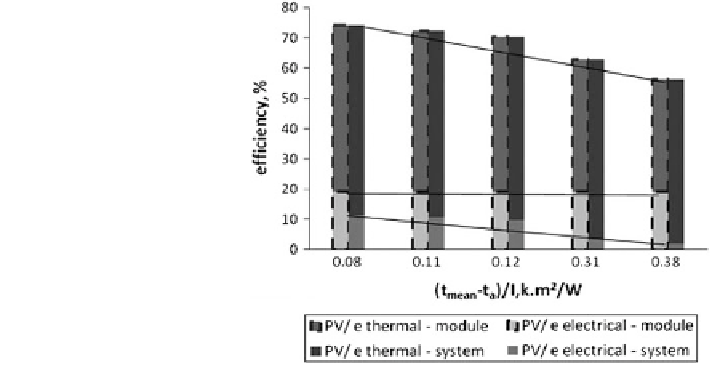Civil Engineering Reference
In-Depth Information
Fig. 23 Variation in
efficiencies with external and
operating conditions (Zhao
et al.
2011
) (PV/
e photovoltaic/evaporator;
t
mean
mean temperature at PV
cells; t
a
air temperature)
achieve owing to the numerous joints in existence. There is also high risk of
refrigerant leakage, and achieving balanced refrigerant distribution across the
multiple coils installed at a large PV panel area is technically difficult.
Heat-pipe-based PV/T
Heat-pipe-based PV/T is also a relatively new technology, and researches into this
subject were found very limited. Up-to-date, flat-plate and oscillating heat pipes
were studied for potential use in PV cooling, and the results indicated that the heat
pipes may have potential to overcome the problems existing in refrigerant-based
system, e.g. possible leakage of refrigerant, unbalanced distribution of refrigerant
flow and difficulty in retaining pressurisation or depressurisation states in different
parts of the system.
This system usually operates in conjunction with a heat pump or a heat cycle,
and its performance is justified by the electrical and thermal efficiencies of the PV/
T modules and the heat pipe heat transport capacity. These performance param-
eters (efficiencies and heat transport capacity) vary with the structure/material and
vacuum degree of the heat pipe, type of the heat pipe fluid, temperature and flow
rate of the secondary fluid, PV type and external climatic conditions. The most
favourite unit configuration and material are the commercial PV wafers attached
on the aluminium flat-plate heat pipes, while its headers locate in a water manifold
and all the unit joints are connected with thermally conductive silicon grease
(Zhao et al.
2010
). A diagram showing interrelation between solar efficiencies and
the running time is presented in Fig.
24
, which is developed on the basis of the
fixed geometrical conditions and PV type.
In overall, a typical heat-pipe-based PV/T type (Zhao et al.
2010
) can achieve
maximum electrical efficiency of around 10 % and thermal efficiency of around
58 %. Researches related to heat-pipe-based PV/T system usually focus on (1)
determining appropriate heat pipe structure/material and vacuum degree, heat pipe
fluid type and volume, flow rate and inlet temperature of the secondary fluid, (2)

